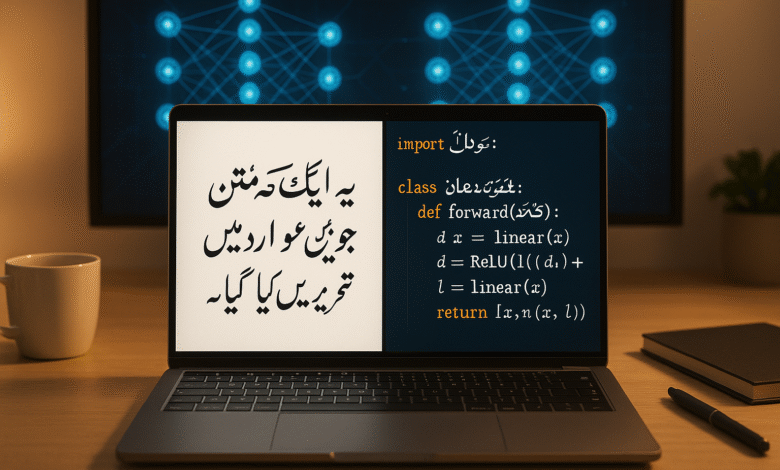Building Simple AI Applications with Urdu Language Processing: A Developer’s Guide
Learn to build AI applications with Urdu language processing. Complete developer guide covering NLP, tokenization, sentiment analysis & deployment tips.

The rapid advancement of artificial intelligence has opened unprecedented opportunities for developers to create applications that understand and process regional languages. Among these, building AI applications with Urdu language processing presents unique challenges and immense potential for reaching millions of native speakers across Pakistan, India, and the global diaspora. This comprehensive guide explores the technical foundations, practical implementation strategies, and best practices for developing robust Urdu NLP applications.
Understanding Urdu Language Processing in AI Context
Urdu, with its rich linguistic heritage and complex script, requires specialized approaches in natural language processing. Unlike English, Urdu follows a right-to-left writing system, uses Arabic script with additional characters, and exhibits significant morphological complexity. These characteristics make AI applications with Urdu language processing particularly challenging yet rewarding for developers.
The growing demand for Urdu-enabled AI solutions stems from the language’s widespread usage by over 230 million speakers worldwide. From customer service chatbots to content management systems, businesses increasingly recognize the need for AI applications that can effectively process and understand Urdu text and speech.
Modern machine learning frameworks have evolved to support multilingual processing, making it more feasible to develop sophisticated Urdu language applications. The key lies in understanding the linguistic nuances and leveraging appropriate technological approaches.
Technical Prerequisites for Urdu NLP Development
Programming Languages and Frameworks
Python remains the dominant choice for building AI applications with Urdu language processing due to its extensive ecosystem of NLP libraries. Essential frameworks include:
TensorFlow and PyTorch provide robust neural network capabilities for developing custom Urdu language models. These frameworks support Unicode handling, crucial for processing Urdu text correctly.
spaCy offers excellent multilingual support and can be extended with custom Urdu language models. Its industrial-strength NLP capabilities make it ideal for production-ready applications.
NLTK (Natural Language Toolkit) provides fundamental text processing tools that can be adapted for Urdu text analysis, including tokenization, stemming, and part-of-speech tagging.
Transformers library by Hugging Face enables developers to leverage pre-trained multilingual models and fine-tune them for specific Urdu language tasks.
Text Processing Challenges
Urdu text processing presents several unique challenges that developers must address when building AI applications:
Script Complexity: Urdu uses a modified Arabic script with additional characters. The script is cursive, meaning letters change form based on their position in words. This contextual variation requires sophisticated text processing algorithms.
Directionality: The right-to-left text direction affects how applications display and process text. Proper handling of bidirectional text is essential for user interface design and text analysis.
Morphological Richness: Urdu exhibits complex morphological patterns with extensive use of prefixes, suffixes, and inflections. This complexity requires advanced tokenization and stemming algorithms.
Diacritical Marks: While often omitted in everyday writing, diacritical marks significantly affect pronunciation and meaning. AI applications must handle both marked and unmarked text effectively.
Setting Up Your Development Environment
Essential Libraries and Tools
Creating a robust development environment for AI applications with Urdu language processing requires careful selection of tools and libraries:
# Essential Python packages for Urdu NLP
pip install tensorflow
pip install torch
pip install transformers
pip install spacy
pip install nltk
pip install pandas
pip install numpy
pip install arabic-reshaper
pip install python-bidi
Unicode Support: Ensure your development environment properly handles Unicode characters. Configure your IDE and terminal to display Urdu text correctly.
Font Configuration: Install appropriate Urdu fonts like Jameel Noori Nastaleeq or Noto Nastaliq Urdu for proper text rendering in your applications.
Text Editors: Use editors that support right-to-left text editing, such as Visual Studio Code with appropriate extensions or specialized Urdu text editors.
Data Preparation and Preprocessing
Effective data preprocessing forms the foundation of successful AI applications with Urdu language processing. Key preprocessing steps include:
Text Normalization: Convert text to a consistent format by handling different Unicode encodings and normalizing character representations.
Tokenization: Implement Urdu-specific tokenization algorithms that properly handle word boundaries, punctuation, and special characters.
Noise Removal: Clean text data by removing irrelevant characters, correcting encoding errors, and handling mixed-language content.
Stemming and Lemmatization: Develop or utilize existing Urdu stemming algorithms to reduce words to their root forms for better analysis.
Read More: Future of AI Jobs in Pakistan: What Skills Are in Demand?
Core Components of Urdu Language Processing
Tokenization Strategies
Tokenization in Urdu requires specialized approaches due to the language’s unique characteristics. Traditional whitespace-based tokenization often fails to properly segment Urdu text.
Word-level Tokenization: Implement algorithms that understand Urdu word boundaries, considering the cursive nature of the script and the absence of consistent spacing.
Morphological Tokenization: Break down words into meaningful morphological components, separating roots, prefixes, and suffixes for deeper analysis.
Subword Tokenization: Utilize byte-pair encoding (BPE) or SentencePiece algorithms to handle out-of-vocabulary words effectively in neural language models.
Part-of-Speech Tagging
Accurate part-of-speech tagging is crucial for building intelligent AI applications with Urdu language processing. Urdu POS tagging involves:
Rule-based Approaches: Develop linguistic rules that identify grammatical patterns specific to Urdu syntax and morphology.
Statistical Methods: Train machine learning models on annotated Urdu corpora to automatically assign POS tags to words in context.
Deep Learning Solutions: Implement neural network architectures like BiLSTM-CRF or transformer-based models for state-of-the-art POS tagging accuracy.
Named Entity Recognition (NER)
Named Entity Recognition in Urdu requires specialized models that understand cultural and linguistic contexts:
Person Names: Recognize Urdu names, including variations in spelling and transliteration from Arabic and Persian origins.
Location Names: Identify geographical entities, considering both local Urdu names and transliterated international locations.
Organizations: Detect company names, institutions, and governmental entities commonly referenced in Urdu text.
Temporal Expressions: Process dates, times, and temporal references using Urdu-specific patterns and calendrical systems.
Building Your First Urdu AI Application
Text Classification System
Creating a text classification system represents an excellent starting point for AI applications with Urdu language processing:
import pandas as pd
from transformers import AutoTokenizer, AutoModelForSequenceClassification
from sklearn.model_selection import train_test_split
class UrduTextClassifier:
def __init__(self, model_name="bert-base-multilingual-cased"):
self.tokenizer = AutoTokenizer.from_pretrained(model_name)
self.model = AutoModelForSequenceClassification.from_pretrained(model_name)
def preprocess_text(self, text):
# Implement Urdu-specific preprocessing
return self.tokenizer(text, truncation=True, padding=True, return_tensors="pt")
def classify(self, text):
inputs = self.preprocess_text(text)
outputs = self.model(**inputs)
return outputs.logits.argmax().item()
Data Collection: Gather diverse Urdu text samples from news articles, social media, and literature to create a comprehensive training dataset.
Model Training: Fine-tune pre-trained multilingual models on your specific Urdu classification task, adjusting hyperparameters for optimal performance.
Evaluation Metrics: Implement appropriate evaluation metrics that account for the unique characteristics of Urdu text and your specific use case.
Sentiment Analysis Implementation
Sentiment analysis for Urdu text requires understanding cultural context and linguistic subtleties:
Lexicon-based Approaches: Develop Urdu sentiment lexicons that capture emotional expressions, idioms, and cultural references.
Machine Learning Models: Train supervised learning models on labeled Urdu sentiment data, using features like n-grams, word embeddings, and syntactic patterns.
Deep Learning Architectures: Implement recurrent neural networks or transformer-based models that can capture long-range dependencies in Urdu text.
Advanced Techniques and Optimization
Transfer Learning for Urdu Models
Transfer learning significantly improves the performance of AI applications with Urdu language processing by leveraging pre-trained multilingual models:
Multilingual BERT: Fine-tune mBERT on Urdu-specific tasks, taking advantage of its pre-trained understanding of multiple languages including Urdu.
XLM-RoBERTa: Utilize this robust multilingual model for various Urdu NLP tasks, benefiting from its improved training methodology.
Custom Model Development: Train domain-specific models from scratch when sufficient Urdu data is available for your particular use case.
Handling Code-Switching and Mixed Languages
Urdu text often contains code-switching between Urdu, English, and regional languages. Effective handling strategies include:
Language Detection: Implement algorithms that identify language boundaries within mixed-language text.
Multilingual Processing: Develop systems that can simultaneously process multiple languages within the same document or conversation.
Context Preservation: Maintain semantic coherence across language switches while preserving the original meaning and intent.
Performance Optimization
Optimizing AI applications with Urdu language processing requires attention to both computational efficiency and accuracy:
Model Compression: Implement techniques like knowledge distillation, pruning, and quantization to reduce model size without sacrificing performance.
Caching Strategies: Develop intelligent caching mechanisms for frequently processed Urdu text patterns and common queries.
Batch Processing: Optimize text processing pipelines for batch operations to improve throughput in production environments.
Deployment and Production Considerations
Scalability and Infrastructure
Deploying AI applications with Urdu language processing at scale requires robust infrastructure planning:
Cloud Services: Leverage cloud platforms like AWS, Google Cloud, or Azure that provide scalable compute resources and managed AI services.
Containerization: Use Docker and Kubernetes for consistent deployment across different environments and easy scaling.
API Design: Develop RESTful APIs that can handle Urdu text input and output efficiently, with proper error handling and response formatting.
Security and Privacy
Protecting user data and ensuring secure processing of Urdu text involves:
Data Encryption: Implement end-to-end encryption for sensitive Urdu text data in transit and at rest.
Access Control: Establish proper authentication and authorization mechanisms for API access and data management.
Compliance: Ensure adherence to relevant data protection regulations and cultural sensitivities regarding Urdu content.
Monitoring and Maintenance
Maintaining production AI applications with Urdu language processing requires continuous monitoring:
Performance Metrics: Track key performance indicators including accuracy, response time, and resource utilization.
Error Handling: Implement comprehensive error logging and alerting systems for production issues.
Model Updates: Establish processes for regularly updating models with new Urdu language data and improving performance.
Real-World Applications and Use Cases
Customer Service Chatbots
Urdu-enabled chatbots represent one of the most practical applications of AI applications with Urdu language processing:
Intent Recognition: Develop systems that understand customer queries in natural Urdu language, accounting for regional variations and colloquialisms.
Response Generation: Create contextually appropriate responses in fluent Urdu, maintaining conversational flow and cultural sensitivity.
Integration: Seamlessly integrate with existing customer service platforms and CRM systems.
Content Management Systems
Organizations dealing with Urdu content benefit from AI-powered content management:
Automatic Categorization: Classify Urdu documents and articles into appropriate categories based on content analysis.
Duplicate Detection: Identify similar or duplicate Urdu content across large document repositories.
Search Enhancement: Improve search functionality with semantic understanding of Urdu queries and content.
Educational Technology
Educational applications leveraging AI applications with Urdu language processing can significantly impact learning outcomes:
Language Learning: Develop applications that help students learn Urdu through interactive exercises and feedback.
Content Analysis: Automatically assess Urdu writing quality and provide constructive feedback to students.
Accessibility: Create tools that make educational content more accessible to Urdu-speaking students.
Future Trends and Opportunities
Emerging Technologies
The future of AI applications with Urdu language processing looks promising with several emerging trends:
Large Language Models: Specialized Urdu language models similar to GPT and BERT are being developed with improved understanding of Urdu context.
Multimodal Processing: Integration of text, speech, and visual processing for comprehensive Urdu language understanding.
Edge Computing: Deployment of Urdu NLP models on mobile devices and edge hardware for improved performance and privacy.
Market Opportunities
Growing market demand for Urdu AI applications presents numerous opportunities:
Government Services: Digital transformation initiatives requiring Urdu language support for citizen services.
Healthcare: Medical applications that can process Urdu patient records and provide health information in native language.
E-commerce: Online platforms needing Urdu language support for product descriptions, reviews, and customer interactions.
Conclusion
Building AI applications with Urdu language processing requires a deep understanding of both technical implementation and linguistic nuances. This guide has provided comprehensive coverage of the essential components, from basic setup to advanced optimization techniques.
The key to success lies in combining robust technical approaches with cultural sensitivity and linguistic expertise. As the field continues to evolve, developers who master these skills will be well-positioned to create innovative solutions that serve the growing Urdu-speaking population worldwide.
Whether you’re developing customer service chatbots, content management systems, or educational tools, the principles and techniques outlined in this guide provide a solid foundation for building effective AI applications with Urdu language processing. The future holds immense potential for developers willing to invest in understanding and implementing these technologies.
By following the best practices and implementation strategies discussed here, developers can create sophisticated AI applications that not only process Urdu text accurately but also respect the cultural and linguistic heritage of this beautiful language. The journey of building Urdu AI applications is challenging but ultimately rewarding, offering the opportunity to bridge technology and culture in meaningful ways.











